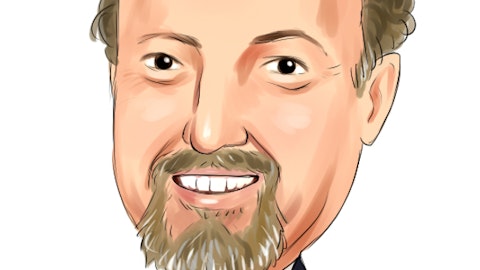Arm Holdings plc American Depositary Shares (NASDAQ:ARM) Q3 2024 Earnings Call Transcript February 7, 2024
Arm Holdings plc American Depositary Shares isn’t one of the 30 most popular stocks among hedge funds at the end of the third quarter (see the details here).
Operator: Thank you for standing by, and welcome to Arm’s Third Quarter Fiscal Year-End 2024 Earnings Conference Call. At this time, all participants are in a listen-only mode. After the speakers’ presentation, there will be a question-and-answer session. [Operator Instructions] I would now like to hand the call over to Head of Investor Relations, Ian Thornton. Please go ahead.
Ian Thornton: Thank you, Latif. Thank you, everybody. My name is Ian Thornton, and I’m the Head of Investor Relations at Arm. I would like to welcome you to our earnings conference call for the third quarter of the fiscal year ending March 31, 2024. I’m joined today by Rene Haas, the Chief Executive Officer of Arm; and Jason Child, Arm’s Chief Financial Officer. Hopefully, you will all have downloaded and read the shareholder letter. If not, it is available on the Arm Investor Relations website at investors.arm.com. The shareholder letter provides a rich update on our strategic progress in the quarter. Before we begin, I’d like to remind everyone that during the course of this conference call, Arm will discuss forecasts, targets and other forward-looking information regarding the company and its financial results.
While these statements represent our best current judgment about the future results and performance as of today, our actual results are subject to many risks and uncertainties that could cause actual results to differ materially from what we expect. In addition to any risks that we highlight during this call, important risk factors that may affect our future results and performance are described in our registration statement on Form S-1 filed with the SEC on September 14, 2023. Arm assumes no obligation to update any forward-looking statements, which speak only as of the date they are made. In addition, we refer to non-GAAP financial measures during the discussion. Reconciliations of certain of these non-GAAP financial measures to the most directly comparable GAAP financial measures and a discussion of certain projected non-GAAP financial measures that we were not able to reconcile without unreasonable efforts and supplementary financial information can be found in the shareholder letter that we released earlier today.
The shareholder letter and other earnings related materials are available on our website at investors.arm.com. And with that, I’ll turn the call over to Rene, who has some prepared remarks.

A businessman negotiating a deal in a modern sleek office.
Rene Haas: Thank you, Ian, and good afternoon, good evening, everyone. So I’d like to take a few different comments about the quarter, and then I’ll turn it over to Jason for some specifics and then, we’ll open it up to Q&A. We had an outstanding third quarter inside the company. We could not be more pleased. Record revenues, we exceeded the high end of the range for the guidance and extremely pleased about results overall. For Q4, we’re expecting another record quarter, and to that end, we’ve also raised guidance on which Jason is going to give more color on. But a little bit regarding the why and how we got here. Arm has the most fundamental, foundational pervasive compute platform really in the history of digital design. Over 280 billion units in the 30 plus years that Arm has been a company have been built.
And that has underpinned a software ecosystem and hardware ecosystem like no other. And given the fact that a CPU design is really driven by the hardware and the software, it creates a flywheel for continuous development. That is the more hardware that exists on Arm, the more software that’s written for Arm, the more software that’s written for Arm, the more popular the hardware. So we’re building off a fantastic base that when we look at what happened in the last quarter, not only did we see growth driven by a number of factors but growth that we think is long term and sustainable. For royalties specifically around some of the products that shipped in the quarter, we’ve seen a significant transition now continuing from our v8 product to our v9 product.
Our v9 product garners roughly 2x the royalty rate of the equivalent v8 product, and whereas in the previous quarter that was about 10% of our revenue for royalties. It’s now moved to 15%. And that has seen growth in not only the smartphone sector but also in infrastructure and other markets, which drives growth. We are also seeing strong momentum and tailwinds from all things AI. From the most complex devices on the planet for training and inference, the NVIDIA Grace Hopper 200 to edge devices such as the Gemini Nano Pixel 6 from Google or the Samsung Galaxy S24, more and more AI is running on more end devices, and that’s all running on Arm. And what that has done is driven a very strong set of tailwinds for our licensing growth. When we look at demand for new products from a licensing standpoint, what we are finding from the end market is that we’ve reached nowhere near good enough relative to the capability of the technology, and end customers for new designs are needing more and more Arm technology to keep up, particularly with the AI demands.
So with that, our licensing growth has been very strong. We’ve also seen proof points around one of our strategies that we call Compute Subsystems. These are complete finished blocks of designs that we put together for our end customers that will save them significant time around validation of their engineering work and also around time-to-market relative to cycling products to the fab. One of the very first designs that was made public that uses this is the Microsoft Cobalt, which uses our Neoverse cores of 128 CPUs to be specific. We worked very closely with Microsoft around these designs using Compute Subsystems, and we see this trend only going to continue. So between strong growth in royalties that are driven between v8 to v9, all things AI needing energy efficient compute and Compute Subsystems, we feel very, very strongly positioned for growth.
And again, this is completely underpinned by an ecosystem of devices that are in the installed base and a very, very large software community that develops on Arm. So with that, I will turn it over to Jason and then we’ll open it up for Q&A.
Jason Child: Thank you, Rene. I’m going to briefly touch on guidance for the fourth quarter and full year. Starting with revenues. For fiscal Q4, we are guiding to a range of $850 million to $900 million with a mid-point of $875 million. This represents a raise of over $95 million compared to our prior implied guidance for the fourth quarter. When combined with our strong Q3 performance, the full year revenue guidance rises to $3.155 billion to $3.205 billion, an increase of $160 million at the midpoint versus prior. Within Q4 total revenue, we expect royalty revenues to grow mid-single digits sequentially and to be up over 30% year-over-year as we compare against the bottom of the industry wide inventory correction that occurred in prior year Q4.
Royalty revenue sequential growth is mainly coming from increasing penetration of Armv9, where royalty rates are on average, at least double the rates on equivalent Armv8 products. Additionally, we are seeing an increasing amount of Arm technology in chips being deployed and as the amount of Arm technology in chips increases, so does the royalty rate. With around 35% of Arm’s total, sorry, Arm’s royalty revenue coming from smartphones, we have benefited from recovery in the smartphone market. But with 65% coming from markets beyond mobile, we are seeing more revenue growth from share gains and market share growth outside of mobile. Additionally, we are expecting another strong quarter for licensing with revenue up sequentially to near record levels.
As with recent quarters, we expect to sign multiple new ATA deals in Q4, and demand for our latest technology remains high as customers need access to AI-capable CPUs and related technology such as our Compute Subsystems. Turning to expenses. We expect non-GAAP OpEx of approximately $490 million in Q4 and $1.7 billion for the full year. On a like-for-like basis, our full year guidance has increased by $10 million, driven by slightly higher spend in R&D. As detailed in the guidance section of our shareholder letter, to increase transparency and improve the comparability of our results, beginning in Q4, the presentation of our non-GAAP measures will be modified to exclude employer taxes related to equity classified awards. These taxes are dependent on our stock price at the time of vesting and, as a result, fluctuate independently of the operating performance of our business.
The impact of this change has been factored into today’s non-GAAP Q4 and full year guidance for operating expenses and fully diluted EPS. On an EPS basis, revenue strength will flow through to profit, driving Q4 non-GAAP fully diluted EPS up to between $0.28 and $0.32 and full year non-GAAP fully diluted EPS to up between $1.20 and $1.24. In summary, we had an outstanding Q3 and expect our momentum to accelerate through Q4 and beyond. With that, I will now turn it back over to the operator to kick off the Q&A portion of the call.
See also 15 Reasons Why Millionaires Think They’re Middle Class and 15 Most Powerful Asian Countries in 2024.
Q&A Session
Follow Asiarim Corp (OTCMKTS:ARMC)
Follow Asiarim Corp (OTCMKTS:ARMC)
Operator: Thank you. [Operator Instructions] Our first question comes from the line of Harlan Sur of JPMorgan. Your question, please, Harlan.
Harlan Sur: Yes. Thank you. Good afternoon and congratulations on the strong results, guidance and, of course, execution. December quarter, as you guys mentioned, right, second consecutive quarter of strong licensing, second consecutive quarter of book-to-bill greater than 1, strong ACV. It sounds like many of your customers across all of your end markets are focusing on accelerated compute and AI and the requirements for more compute capability. And that’s obviously being reflected in the strong licensing performance. How much of the expansion on recent licensing deals has been more about adding your AI specific IP, right? Like, your Ethos NPU or taking advantage of some of your Helium and Neon vector extensions for AI workloads or Compute Subsystems adoption versus just buying up the stack on more powerful cores? And then more importantly, like do you guys see the strong licensing momentum continuing into fiscal ’25?
Rene Haas: Yeah. Hi, Harlan and thank you for the kind words. I’ll take the first part of your question and then let Jason comment on the second half. One of the new products that we released relative from a licensing standpoint is something we call Arm Total Access, which Jason referred to as ATA. That gives customers access to a broad set of Arm technology including our most advanced CPUs and NPUs. And one of the things that we are seeing is exactly what you described. We’re seeing demand for incorporating CPUs with anything that helps with AI acceleration such as vector extensions. Additionally, the ATAs give customers access to the NPUs, which they can also use for an off-load. What we are seeing anecdotally relative to when we engage customers is that the need for more compute, the need to be able to handle what I would call ability unknown relative to these large language models that either run on an edge device or in a hybrid way is fundamentally driving a need for more compute than they had before.
So they are looking to upgrade to give themselves flexibility on the design and also to maximize their ability to deliver the most efficient product, whether that’s lots of different cores or a smaller set of devices that may or may not include an NPU. So in summary, yes, your question, I think, is accurate relative to the conclusion of AI demand is driving a need for a lot of different products. And I’ll let Jason kind of comment to the longer-term trend that we see.
Jason Child: Yeah. Harlan, I would say on the looking forward, so obviously, I only gave guidance for Q4. But going beyond that, when you unpack licensing versus royalty, because of the fact that we’re largely almost entirely under contract for next year on royalties, we feel good about those trends. It’s the license piece that’s a little harder to forecast. If I look at last quarter and this — in Q4, that’s coming up, we’ve definitely had some upside from AI and selling additional licenses that were just not in our plan and not anticipated. So I think, we’re going to need to work through this quarter to find out how much of that upside continues to – and that trend flows into next year because we’ve seen this demand has been coming, I think, little shorter sales cycles than we had seen typically before. So I’d say stay tuned, and in 90 days, we’ll give you a better view.
Harlan Sur: No helpful. Thank you very much.
Operator: Thank you. Our next question comes from the line of Gary Mobley of Wells Fargo. Your question, please. Gary?
Gary Mobley: Hi, guys. Thanks very much for taking my question. Let me extend my congratulations to the entire Arm team for the strong results. Can’t help but notice the strength in business from Arm China. Maybe if you can speak to what drove that strong result out of Arm China? And besides Arm China, were there any other greater than 10% customers in the quarter?
Rene Haas: Yeah. I would say broadly speaking, we are seeing increased market share gains for our products across the board, particularly around automotive and infrastructure/data center. Inside China, those are very good growth markets. One of the things we continue to comment on relative to the China market is that the China ecosystem tends to follow the global ecosystem. So as we see the share gains across different aspects of the market, we’re seeing that consistent and holding true relative to China. Jason, do you want to take the other part of that?
Jason Child: Yeah. Just on the numbers to make sure it’s clear. So when we announce related parties, I think we’re about 30% of growth. Arm China is the largest portion of it. However, there are others. So Arm China was about 25% of total revenue, just slightly up from the 20% from a quarter ago.
Gary Mobley: That’s helpful. The gains in the royalty rate per unit, if I can add a follow-on, certainly are accelerating. Is that all driven by Armv9? And should we continue to expect that upward inflection in the royalty rate per unit?
Rene Haas: Yeah. I think that’s the right way to think about it. So as mentioned, Armv9 was 10% of our royalty revenue last quarter, now 15%. We see that accelerating. The other thing we are seeing is that the mixes of devices that might have a mix of v8 and v9 cores are increasingly moving to more v9 cores. And the reason for that is back to the AI comment, the compute needs of the end applications only continues to increase. And what we’re seeing is customers looking to put more and more technology into their devices perhaps even more than they originally planned for when they had licensed the technology. So it’s a compounding effect of growth. We see growth from royalty happening from v8 to v9 transition and more Arm technology being used in the same devices. So it’s a bit of a compounding effect that helps us with growth.
Gary Mobley: Thank you.
Operator: Thank you. Our next question comes from the line of Thomas O’Malley of Barclays. Your question, please. Thomas?
Thomas O’Malley: Hey, guys. Thanks for taking my question and congrats on the nice results. I just want to add a question to the v9 pile here. You guys are talking about traction in AI, smartphones, infrastructure. You’re saying that, that percentage — as a percentage of total revenue grows into the next fiscal year. Where are you seeing the most of that traction? You called out AI a couple of times here early in the call. But is that coming more from the smartphone side or the AI side? And just maybe talk about the cadence of where you see that penetration rate growing as you get into the next fiscal year. Thank you.
Rene Haas: Yeah. So thanks for the question. So a couple of ways to think about it. There’s definitely growth coming from the data center side. So proof points such as NVIDIA’s Grace Hopper, the Microsoft Cobalt design, the work that AWS has been doing in Graviton. What we are seeing is more and more AI demands in the data center, whether that’s around training or inference. And because the Arm solution in the data center, in particular, is extremely good in terms of performance per watt and the constraints that are on today’s data center is relative to running these AI workloads puts a huge demand on power, that’s a great tailwind for Arm. If we move to the edge devices such as a smartphone, we’ve seen, and I think the recent launches, as I mentioned, with Gemini Nano and the Galaxy S24, increased AI workloads being pushed to the phone.
And what we’re seeing from the design standpoint is more and more compute technology being pushed into those phones such that they are AI capable and AI ready because this field is moving very, very fast. A year from now, who knows what the type of AI applications it might be able to run on a smartphone. So what we’re seeing is a shift to more and more high performance capable technology to capture a wave to ensure that they can run these AI workloads. Nobody wants to be caught behind with not enough performance when the new application comes out. So that has accelerated the v9 adoption, both from a standpoint of more devices using it and more devices using more of it. And to your question, where is it coming from? It’s coming from everywhere.





